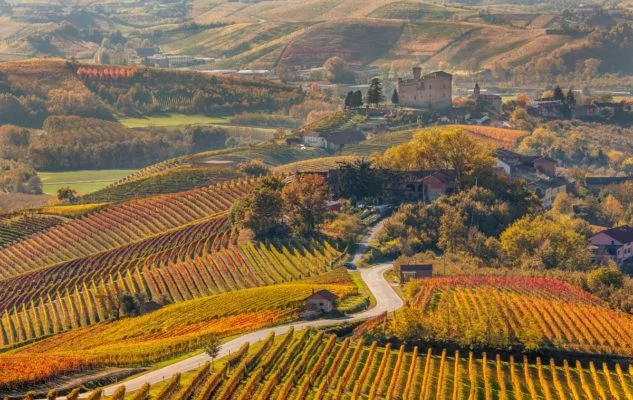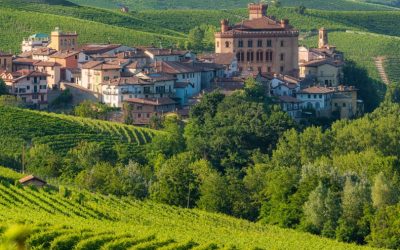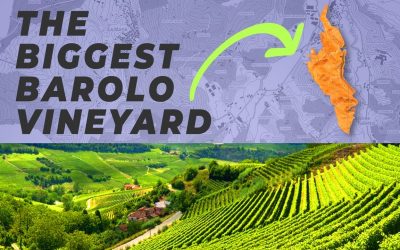Barolo Vineyards Tour: Unveiling the Magic of Langhe area
Nestled in the rolling hills of Italy’s Piedmont region, Barolo is a wine lover’s paradise. Known for its robust, complex red wines made from the Nebbiolo grape, the vineyards of Barolo have a magnetic charm that’s undeniable.
Understanding the Langhe Area
Langhe, a hilly region located in the heart of Piedmont, Italy, is known for its picturesque landscapes, rich history, and culinary delights, most notably, its world-class wines. The area encompasses numerous communes including Alba, Barolo, La Morra, Serralunga d’Alba, Castiglione Falletto, and Monforte d’Alba, each with its distinct wine style. Offering a tapestry of vineyard-covered hills, dotted with medieval castles and villages, Langhe paints an enchanting picture that attracts wine enthusiasts, foodies, and tourists alike.
The Diversity of the Communes in the Langhe Area
Each commune within the Langhe area offers a unique combination of soil composition, climate, and elevation, contributing to the distinct flavor profiles of the wines produced. For instance, Barolo is recognized for its structured, long-lived wines, La Morra for its softer, fruitier expressions, and Serralunga d’Alba for its powerful, robust wines. These variations make exploring the wine scene in Langhe an exciting journey of discovery.
The Volume of Wine Production in Langhe
Despite its relatively small geographical size, Langhe produces an impressive volume of wine. To put this into perspective, the annual production of Barolo wine alone is around 11 million bottles. If one were to stack these bottles, they could create a column roughly 14 times higher than Mount Everest! However, even with such substantial production, the demand for these exceptional wines continues to grow globally. From this perspective, Langhe not only embodies the charm of the Italian countryside but also stands as a significant player in the global wine industry.
Barolo Vineyards in Langhe area

Barolo, one of Italy’s most prestigious wine regions and indeed the world, is renowned for its signature red wine made from the Nebbiolo grape. Situated in the Langhe area of Piedmont, it’s found on the right bank of the Tanaro River.
The Barolo vineyards stretch across eleven communes, spanning a total area of around 1,700 hectares. To put that into perspective, that’s roughly equivalent to 2,360 football fields! The vineyard area is divided into over 1,200 plots owned by approximately 500 winegrowers. Despite the use of the Nebbiolo grape being a common factor, the wines produced from different vineyards exhibit a range of nuances due to the variation in soil composition and microclimates.
The production of Barolo wine, though high in quality, is not massive in terms of quantity. The yearly output of Barolo is about 13.2 million bottles, which may seem like a lot, but in comparison, beverage giants like Coca-Cola and PepsiCo produce approximately 33 billion and 12 billion units respectively. If we consider Red Bull, they produced 7.5 billion cans in 2019. So, the production of Barolo wine only represents a small fraction, less than 0.1% of these giants’ production. This stark difference further highlights the exclusivity and rarity of Barolo wines in the global beverage market.
Barolo’s Mosaic of Vineyards

Barolo’s vineyards are a mosaic of unique ‘crus’, or individual vineyards, each offering a distinct interpretation of the Nebbiolo grape. Some of the most notable vineyards include Cannubi, Sarmassa, Brunate, Rocche dell’Annunziata, and Cerequio.
- Cannubi: Believed to be the oldest vineyard of Barolo, it offers wines that are known for their elegance, complex aromas and longevity.
- Sarmassa: Located close to Cannubi, it gives rich and full-bodied wines with excellent aging potential.
- Brunate: Situated in the commune of La Morra, its wines are known for their structure and complex bouquet of scents.
- Rocche dell’Annunziata: Also in La Morra, it’s known for wines with a characteristic finesse and fragrance.
- Cerequio: Straddling the communes of La Morra and Barolo, it produces powerful, structured wines that age remarkably well.
Each of these vineyards contributes to the richness of Barolo wine, expressing the essence of the Nebbiolo grape while reflecting the character of their individual terroir. The vineyards of Barolo are a testament to the region’s commitment to maintaining tradition while continuously seeking excellence in winemaking.
Understanding Barolo: The ‘King of Wines’
Before delving into the vineyards themselves, it’s important to understand what makes Barolo wines so special. From the unique soil composition to the meticulous winemaking processes, explore the nuances that make Barolo the ‘King of Wines’.
Is the Best Barolo from Serralunga d’Alba? Insights from the Pira Winery
Determining the best Barolo wine boils down to personal preference, considering the diversity in flavor profiles across different vineyards and wineries. Nonetheless, Serralunga d’Alba, a region nestled in the heart of Barolo, is renowned for producing exceptional Barolo wines, boasting unique aromas and textures that have captivated the palates of wine connoisseurs worldwide.
The Pira Winery, a family-operated establishment situated in Serralunga d’Alba, holds a significant role in this reputation. The Pira family has harnessed the distinctive characteristics of each of their vineyards to craft Barolo wines of high acclaim. The mineral traits of Barolo Margheria, the potency of Barolo Marenca, and the elegance of Barolo Vignarionda are all reflections of the exceptional terroir of Serralunga d’Alba. Therefore, while pinpointing the absolute ‘best’ Barolo may depend on personal taste, it’s clear that Serralunga d’Alba’s Pira Winery is a key player in the region’s wine-making excellence.
Starting the Journey: Barolo Vineyard Overview
Here’s an overview of the top vineyards you cannot miss when touring Barolo. Each with its unique character, these vineyards provide a diverse range of experiences for every wine enthusiast.
Spotlight on Renowned Vineyards: Marchesi di Barolo and Ceretto
Dive into a detailed exploration of two of Barolo’s most esteemed vineyards. Learn about their history, the range of wines they produce, and what makes them unique in the world of Barolo.
Hidden Gems: Discovering Lesser-Known Vineyards in Barolo
Barolo, the “king of wines and wine of kings”, is renowned worldwide for its rich, full-bodied red wines produced from the Nebbiolo grape. The vineyards of Barolo stretch across a mosaic of plots in the Langhe hills of Piedmont, each offering its own unique terroir. While the region’s iconic vineyards such as Cannubi and Cerequio often steal the spotlight, there are many lesser-known vineyards in Barolo producing exceptional wines. This article aims to take you on a journey of discovery through some of these hidden gems.
Located in the commune of Barolo itself, Bricco delle Viole is appreciated for its aromatic elegance. The vineyard sits at one of the highest elevations in the region, which helps maintain the grapes’ acidity and develop complex aromatic profiles.
-
Mosconi:
The Powerhouse
In Monforte d’Alba, Mosconi Vineyard is known for producing Barolos with a muscular and powerful style. The rich, clay-heavy soil in this vineyard contributes to the structured, tannic wines it produces.
-
Ravera: The Balanced Harmony
Ravera, located in the commune of Novello, offers wines known for their balance between power and elegance. Its soil composition, combined with an optimal South-Eastern exposure, allows for the production of harmonious wines, filled with a distinctive mineral character.
-
Rocche dell’Annunziata: The Fruity Purity
Situated in La Morra, Rocche dell’Annunziata is characterized by the purity of fruit flavors in the wines. The sandy soils provide excellent drainage and contribute to the development of refined tannins, red fruit, and floral notes.
-
Castellero: The Traditionalist
In the heart of Barolo, Castellero stands as a testament to traditional winemaking. This lesser-known vineyard is known for wines that are a quintessential representation of the terroir, offering classic flavors of roses, cherries, and spices.
Conclusion
Venturing off the beaten path in Barolo provides a rewarding experience for any wine enthusiast. While the well-known vineyards produce incredible wines, these lesser-known vineyards offer the chance to discover unique expressions of the Nebbiolo grape, reflecting the rich diversity of the Barolo region. So the next time you’re seeking a bottle of Barolo, consider exploring these hidden gems – they may offer a delightful surprise.
The Culinary Scene of Barolo: Pairing Wine with Food
No trip to Barolo would be complete without indulging in the local cuisine. Discover how Barolo wines pair with traditional Piedmont dishes, elevating the culinary experience to new heights.
Planning Your Visit: Tips and Recommendations
Get some insider tips and recommendations on how to make the most of your Barolo vineyard tour. From the best time to visit, to the must-try wines, this section is a valuable resource for planning your trip.
Is the best Barolo from Serralunga d’Alba? Wine Vlog at Pira winery

Conclusion: Capturing the Spirit of Barolo
Reflect on the enchanting journey through the vineyards of Barolo. Consider how this experience not only deepens your appreciation for Barolo wines but also stirs a connection with the land and people that craft them.
In conclusion, a tour through the Barolo vineyards is more than just a wine tasting experience – it’s a journey into the heart of one of Italy’s most esteemed wine regions, steeped in history, tradition, and the love for fine wines.




